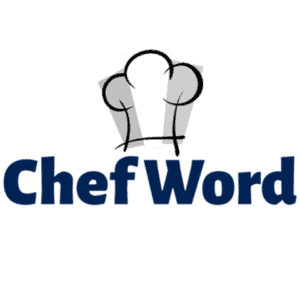What colour chopping board do you use for which food types? This is a question that many people wonder and to those outside of a catering environment the choice of 7 different colours can be confusing!
Fortunately, the reality is that the system is designed to be as straight forward as possible!
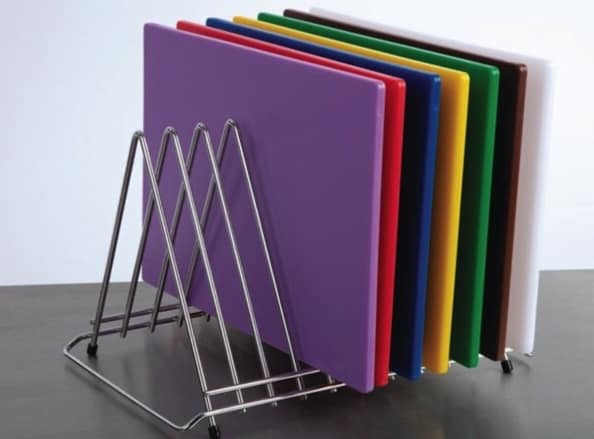
Let’s start by quickly looking at why chefs use different coloured chopping boards?
Chefs use different coloured chopping boards to prevent cross contamination of food types. Even when thoroughly cleaned, bacteria can remain in the knife marks and scratches of a chopping board, therefor the coloured system provides an additional layer of protection.
For example, by always cutting raw meat on a red board, and chopping vegetables on a brown board we help to eliminate any potential cross contamination.
Picture the alternative; we cut raw chicken on a chopping board, and then after washing use the same board to cut cucumbers for a salad! The potential for this to cause serious food poisoning is high.
is high.
There is a risk that some of the bacteria from the chicken can remain on the chopping board and be transferred to the cucumber which we are going to eat raw!
In theory we can wash the chopping board well enough to avoid the cross contamination. However, this is seen as an unnecessary risk to take. By changing boards completely we greatly reduce the risk.
It is a simple and effective system that has a dramatic impact on hygiene levels. All kitchens adopt the system, and all chefs understand the system, as it is standardised across the catering industry.
As the whole chopping board is made in one colour, it is a very visual clue not just to the chef using the board but to all their colleagues around them. It would be very difficult for a professional chef to use the wrong board by accident.
Do Chefs Have To Use Coloured Chopping Boards By Law?
The food standards agency does not require by law that chefs use different coloured chopping boards. A chef can choose to use the same board for all tasks if they wish, so long as they can demonstrate the prevention of cross contamination by heat disinfection.
The food standard agency states;
(To avoid cross contamination you should) “use different equipment (including chopping boards and knives) for raw meat/poultry and ready-to-eat food unless they can be heat disinfected in, for example, a commercial dishwasher”
Source: Food standards agency website
As we can see, they state that we should use different equipment unless it can be heat disinfected. This allows a chef to use a wooden chopping board which they disinfect between food groups if they so wish.
However, this regulation is the main reason chefs choose to follow the coloured chopping board system; we automatically comply with the regulation as we are using different equipment for different food groups.
Most chefs also acknowledge that the coloured board system is a very simple way to comply with good food hygiene practices and are happy to use it!
So that’s the main reason why different coloured boards are used, now we can look at the different colours and what food groups they are used for.
What Are The Different Coloured Chopping Boards?
There are 7 different coloured chopping boards that are used in kitchens, they are:
- Red Chopping Board: Raw Meat
- Yellow Chopping Board: Cooked Meat
- Blue Chopping Board: Raw Fish
- Brown Chopping Board: Vegetables
- Green Chopping Board: Salad and Fruits
- White Chopping Board: Dairy and Breads
- Purple Chopping Board: Free From Ingredients
Some veteran chefs may be wondering where the purple colour chopping board has appeared from!?
It always used to be a 6 colour system, but the purple colour was introduced relatively recently in response to the growing number of customers with food intolerances.
For example, the purple board may be used for ingredients which are free from gluten ; this way the chefs and the customer can be confident their dish has not come into any contact with any other food types that may harm them.
; this way the chefs and the customer can be confident their dish has not come into any contact with any other food types that may harm them.
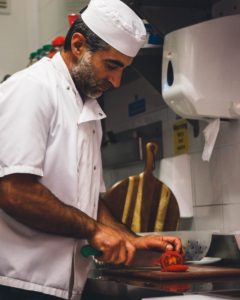
Most readers will find the other coloured board types pretty self explanatory, with the possible exception of differentiating between brown and green.
Just to reiterate, brown is for vegetables and green is for salad and fruits. At first there may appear to be no risk of cross contamination between these two food groups.
However, the reason they are kept separate is that produce cut on a green chopping board are typically eaten raw. We may cut apples, strawberries or cucumbers then eat them straight away.
This requires the highest levels of food hygiene possible. Without cooking food we are most susceptible to the bacteria.
Many vegetables carry soil and debris from the ground into the kitchen. For example, we often have to wash leeks or potatoes to remove the unwanted debris. It is important that this dirt is not transferred to the fruits and salad that we are eating raw!
Most vegetables get cooked in some way, so the debris is washed off and any remaining bacteria is killed during the cooking process.
In reality, we may witness chefs using green boards for chopping vegetables but when following the system correctly this should be avoided.
Some readers may now be questioning if they should be using different coloured chopping boards at home!
Should Cooks At Home Use Different Coloured Chopping Boards?
The majority of home cooks do not need to use different coloured chopping boards. For the amount of cooking we do at home a system like this is not necessary. With just one chopping board to take care of we are far more likely to clean it thoroughly between uses.
thoroughly between uses.
Most home cooks will find that they naturally do food groups in a reasonable order. For example, many cooks will cut the veg on a chopping board before cutting the raw meat. If we choose to cut the meat first we must make sure we thoroughly wash it.
The issue is not so much the food debris we can see on the chopping board; after all we will clean this off when we wash it. The problem lies in the bacteria that gets trapped in the grooves and scratches of the board.
The type of material which the chopping board is made from will have an impact on how much bacteria is able to hide in the knife marks.
Do Chefs Use Wooden Chopping Boards?
Many home cooks favour wooden chopping boards as they look nicer, feel warmer to touch and we are able to scrub them clean easier.
However, most professional kitchens do not use wooden boards. The number of times a board is washed each day in the kitchen would make the wooden board warp and age prematurely. Kitchens also prefer the anti bacterial properties of the materials used in commercial chopping boards.
Whilst wooden chopping boards where universally used for many years with few problems; in modern kitchens, wooden boards tend not to be used as they cannot stand up to the tough environment of professional kitchens over long periods.
over long periods.
With that in mind we shall now look at what material professional chopping boards are made from.
Professional Chopping Board Materials
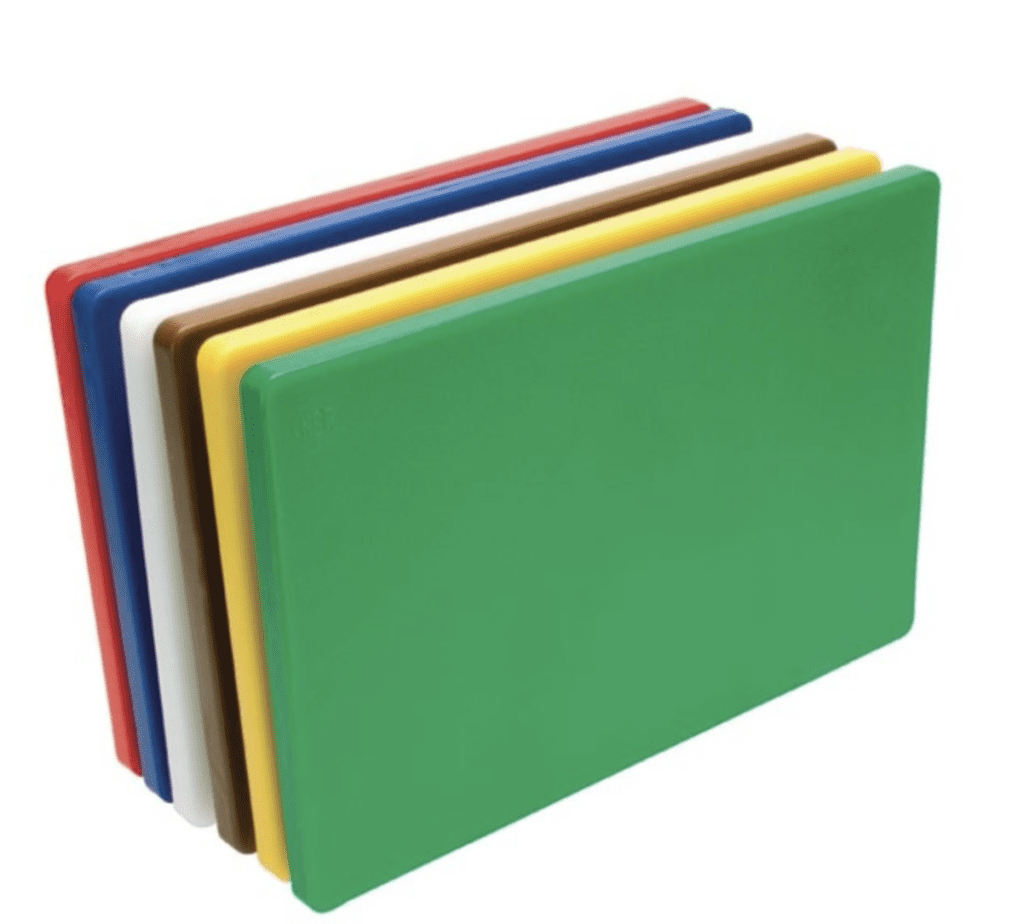
Chopping boards which professional chefs use are made from High Density Polyethylene. This material is a type of plastic which is resistant to scratches, has an antibacterial coating and is also non absorbing, helping to prevent warping.
Chopping boards can also be made from Low Density Polyethylene. This carries the same properties as the high density version above but it makes them more light weight and easy to move around.
The trade-off for the lighter weight is that these low density boards tend to warp over time, although the lower initial price point make them a favourite in many kitchens.
As we have already seen the fact that this material is scratch resistant is a big help in stopping bacteria from getting trapped in the board.
However, it is worth pointing out that even these boards do get knife scratches and warp from the continued heavy use they get, therefor it is vital that the coloured system is still used.
Some chefs may choose to have a wooden chopping board in the kitchen which they use for only one food group. As an example, it is not uncommon to see a chef have a wooden chopping block (similar to the type seen in butchers shops.)
These wooden blocks (link to Amazon) can be very useful when prepping raw meat as they are a lot more sturdy and do not bounce around when a chef is wielding a meat cleaver!
In this circumstance the board will only ever be used for raw meat. Having a specific butchery board in the kitchen is a luxury that many kitchens don’t have the space to be able to own!
Butcher’s blocks are large and heavy items, in contrast chef’s plastic chopping boards are designed to be mobile and fit into any area of the kitchen necessary.
What Are The Different Chopping Board Sizes Available?
Professional kitchen chopping boards tend to come in two different sizes. The large size is usually 600mm x 450mm and the smaller size is 300mm x 255mm. The thickness varies between 10mm – 20mm
Chopping boards made from High Density Polyethylene will typically be thicker and will be noticeably heavier when we pick them up.
How To Store Chopping Boards Correctly
Most kitchens store their chopping boards in a rack. These racks are designed to hold all the chopping boards in place so that the chef can easily access the coloured board they desire.

These racks are definitely worth the investment for 3 main reasons.
- Everyone knows where the boards are located. When rushing around during service it is vital that we can grab the coloured board we need quickly and easily.
- They allow the boards to dry. By holding the boards in an upright position it allows any excess moisture from washing to dry off. This helps preserve the life of the board by preventing warping.
- Allow Easy Access To The Correct Coloured Board. By making it as easy as possible to grab the correct board we are increasing the chance that the system will be followed.
If a chef has to wade through a stack of boards to get to the colour they need, they are more likely to take the easier option and grab the board at the top of the pile regardless of the colour!
Even if we do not have a rack in our kitchen there is a definite benefit to stacking the chopping boards ‘on their side’ rather than one on top of each other.
As well as storing the boards correctly we should also make sure that we are using them in the most effective way possible.
How To Use A Chopping Board Correctly
Perhaps one of the most important things to consider when using a chopping board is how to prevent it from slipping.
On a personal note, one of my pet hates is watching a junior chef trying to cut food on a chopping board that is sliding around all over the work top! It is making the job unnecessarily difficult!
trying to cut food on a chopping board that is sliding around all over the work top! It is making the job unnecessarily difficult!
We must always make sure that the chopping board is fixed firmly in place. We do this by simply wetting a jay cloth or kitchen towel and placing it under the board. This will prevent it from sliding around whilst being used.
It is possible to buy specific non slip mats to go under boards. In my experience a wet tea towel or jay cloth  works perfectly well so this is an unnecessary expense in my opinion.
works perfectly well so this is an unnecessary expense in my opinion.
We may notice that our chopping board is beginning to warp. If we place the cloth in the middle we will often see that the middle is raised and the edges are touching the work surface so the board still slides around.
If this happens we need to either get a bigger cloth that goes all the way to the edge or turn the board over so the warped edges bend upwards.
Once we have a firm base to work on, we can chop at speed without fear of the board moving resulting in us cutting ourselves!
We can now look at how best to look after our chopping boards so we get as much use out of them as possible.
Can Chefs Use Both Sides Of A Chopping Board?
A huge advantage of professional kitchen chopping boards is that they can be turned over to use each side. This is more important than it may seem at first.
As well as it making the board last twice as long, (after all the knife marks and wear and tear are shared between two sides instead of just one), it also prevents food types from tainting one another.
For example, if I where to cut potatoes on a brown board it is perfectly acceptable to then cut carrots afterwards on the same board. However, potatoes leave a waxy residue on the board and on our knife. This makes cutting the carrots more frustrating then it needs to be.
In this instance we simply flip the board over to start using the fresh clean side with no need to go and scrub the board clean!
Beetroot is another example of a food group we need to keep separate.
Anyone who has ever tried to prepare these purple balls, knows that within 2 minutes our hands, knife and chopping board are covered in the staining deep purple juice.
Whilst this is difficult to remove from our hands, it is just as difficult to remove from the chopping board. Even after washing we don’t want this purple dye to transfer onto the next vegetable we are preparing (white onions perhaps)
Again, we can flip the board over and use the fresh side.
Even though we can use both sides it is still important that we thoroughly clean and look after our chopping boards well.
How To Thoroughly Clean A Chopping Board
A set of modern chopping boards can represent a reasonably large financial outlay for a kitchen. Therefor, it is important that we look after them well so that they last us many years of happy chopping.
During a normal working day a chopping board can take a lot of punishment, with chefs knives quickly running across them thousands of times a day.
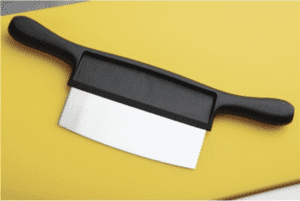
At the end of each shift we must make sure that the boards are thoroughly cleaned. We do this by placing them to soak in hot water and washing up liquid for 15 minutes before using a scrubbing brush to remove as much of the debris as possible.
we must make sure that the boards are thoroughly cleaned. We do this by placing them to soak in hot water and washing up liquid for 15 minutes before using a scrubbing brush to remove as much of the debris as possible.
The scrubbing brush should be soft bristled so that we do not scratch and damage the board further.
Some kitchens choose to soak their chopping boards overnight in water and detergent, however in my option this causes the boards to warp prematurely.
Although the manufactures claim they are non absorbent, they are not designed to be soaked in water for long periods of time and it is inevitable that they will absorb some of the water and begin to change shape.
As the chopping boards get older the amount of scratches and dents in the board will add up. Most kitchens will have boards that show scars where a hot pan was placed on the plastic board by mistake; this creates a deep circular groove that is impossible to remove!
To fix common knife cuts and scratches we can buy a chopping board scraper (like the one pictured above). These are heavy duty scrapers and the idea is that we use them to remove the surface layer from the board so we are left with a smooth, like new finish.
In my experience, these are a good tool – when used. However, most chefs that are pushed for time every day never quite manage to find the time to use them.
every day never quite manage to find the time to use them.
It is often the case that when the chopping boards have too many scratches and are too faded a new set is ordered to replace them.
How Much Do Professional Chopping Boards Cost?
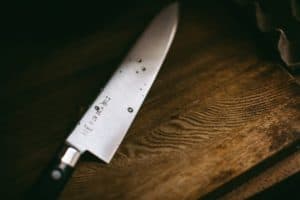
We have mentioned a few times how chefs try and look after their chopping boards as they represent a reasonable investment. Therefor it may be useful to give readers a guide to how much a set of modern chopping boards cost.
The costs vary between suppliers, but perhaps the most popular catering supplier among industry professionals is Nisbets; so theirs are the prices we shall look at. I will include the link the Nisbets page here so readers can easily find the product they are looking for.
so readers can easily find the product they are looking for.
- A large set of High Density Polyethylene boards: £81.99 +VAT
- A Large set of Low density Polyethylene boards: £30.99 + VAT
We can see there is quite a price difference between low and high density sets. The longer life of the high density option should balance the price difference out, but some kitchens prefer the lower up front cost of the low density boards.
When buying colour coded chopping boards some kitchens also choose to purchase corresponding colour coded knives.
Do Chefs Use Colour Coded Knives?
Chefs do not typically use colour coded knives as they are proficient in food safety and this is an unnecessary extra precaution. Colour coded knives are often used in food preparation venues where employees do not have catering qualifications.
Chefs will have a range of their own knives that they use. These are high quality and often very expensive. Each chef’s knives are individual to themselves; they will be the only one to use and sharpen them.
that they use. These are high quality and often very expensive. Each chef’s knives are individual to themselves; they will be the only one to use and sharpen them.
It would be impractical to expect chefs to have colour coded knives for each task. For example a general cooks knife is used to cut vegetables, prepare salad items and slice cooked meat.
In this instance a chef would need the same knife in three different colours to match the chopping board colours being used; not very practical and far too expensive.
Colour coded knives are often seen in kitchens which hire less skilled workers. These type of kitchens don’t typically attract qualified chefs and therefor, as an added layer of food hygiene protection, colour coded knives are provided
The main reasons why a kitchen would use colour coded knives are:
- Basic level kitchens will typically provide knives for the cooks
 to use. For example, a cook in a school canteen will not be expected to purchase their own knives, they will be provided.
to use. For example, a cook in a school canteen will not be expected to purchase their own knives, they will be provided.
As the kitchen is providing the knives they can purchase knives which match the colour boards. As everyone in the kitchen shares the same knives, purchasing one or two in each colour is usually sufficient and relatively inexpensive.
- For those who are not qualified chefs, having colour coded knives provides another opportunity to prevent cross contamination. Less reliance is placed on washing the knife correctly between tasks.
- Colour coded knives are often quite basic and low cost. This makes them a favourite of kitchens that have to purchase knives for everyone to use!
It should be noted that in reality even when colour coded knives are provided, we often see the wrong coloured knife being used on each board. In busy kitchens most cooks will not change knives just to maintain colour coordination, they will wash it instead.
most cooks will not change knives just to maintain colour coordination, they will wash it instead.
Food processing plants are examples of where the colour system will be strictly adhered to but those kind of factory settings are outside the scope of normal kitchen environments.
To Sum Up
I hope this article has given readers an in depth understanding of why the coloured chopping board system is used, and also how to care for our chopping boards so that they last longer.
Like everything that is new, it may take some time for a new chef to remember the exact colours they should be using. However, as we use the system everyday, it will become second nature to any chef within a matter of a few shifts!
